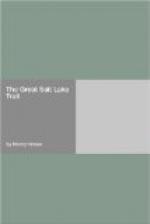Astonished at this manifestation, We-lo-lon-nan-nai offered up a silent prayer, and, divesting himself of his robe, told his followers to bury him in the hot mud up to his head. They complied with his orders, and he remained in the excavation, which was made large enough to receive his entire body, for a whole day; and when taken out at night all his pains were gone, and he seemed to his warriors to have recovered his youth. Many of them who were suffering with different ailments then tried the efficacy of the hot water and the mud, and were from that instant cured.
The report of the miraculous healing of the Ute chief soon spread among the neighbouring tribes, and the sick from everywhere came flocking to the Big Medicine Springs, which they continued to use until the white man took possession of the country, and the Indians have ever since been lessening gradually in number, until there are now but few left, because deprived of their Big Medicine.
We-lo-lon-nan-nai ruled over the Utes for many years after his restoration to health; in fact, never died, but was carried on the wings of an immense bird, which was supposed by the wandering warriors to be a messenger of the Great Spirit, right to the abode of the blessed. His name is revered to this day, and the young men are encouraged to emulate his virtues, the story of which has come down through untold aeons.[59]
To the uninitiated reader, it may, perhaps, be interesting to know the meaning of the somewhat strange Indian cognomens.
The majority of savages receive their names from some peculiarity of person, costume, or from bodily deformity. Ba-oo-kish, or Closed Hand, a noted Crow chief, was thus named from the fact that when young his hand was so badly burned as to cause his fingers to close within the palm, and grow fast. White Forehead, because he always wore a white band around his head to conceal the scar of a wound which had been inflicted by a squaw. Mock-pe-lu-tah, Red Cloud or Bloody Hand, one of the most terrible warriors of the Sioux Nation, derived his name from his deeds of blood, and the red blankets which his braves invariably wore. They “never moved on their enemies without appearing as a cloud, so great were their numbers. Sweeping down with his hosts on the border, he covered the hills like a red cloud in the heavens, and never returned to his village until he had almost exterminated the tribe or settlement against which his wrath was directed.” Ta-shunk-ah-ko-ke-pah-pe, Man afraid of his Horses, obtained his name from having captured a great many horses at one time, which he was constantly afraid he would lose. Once, when the Shoshones attacked his camp, he left his family in the hands of the enemy, to run off his horses. No Knife, a noted man of the Omahas, was named from an incident that occurred at the time of his birth. He was born on the




